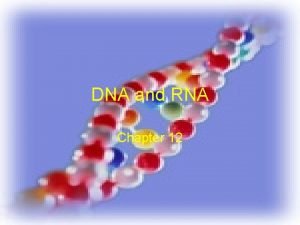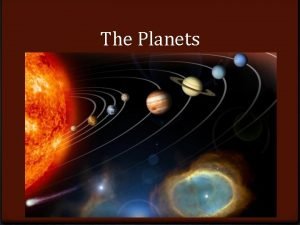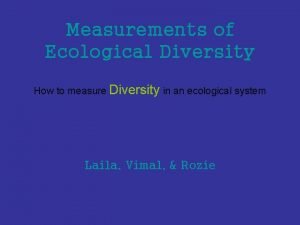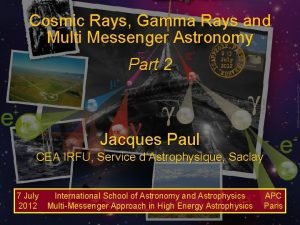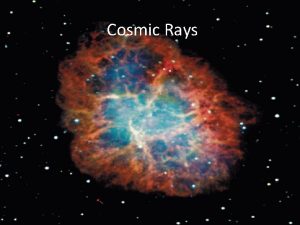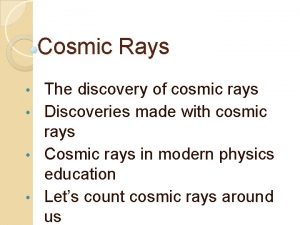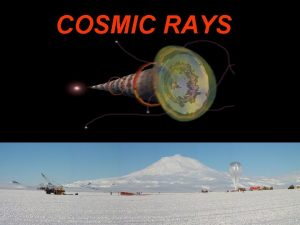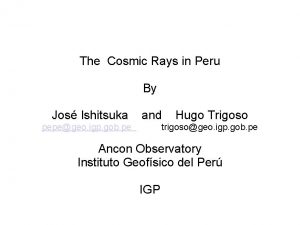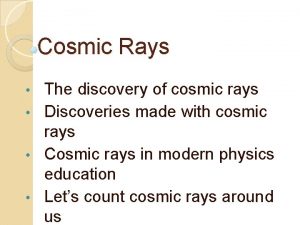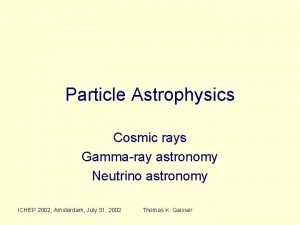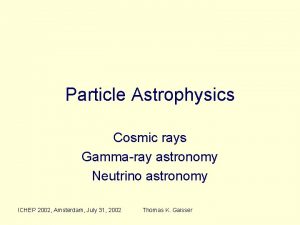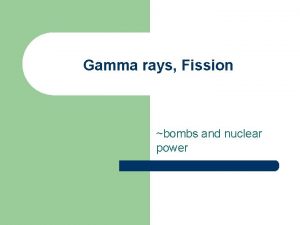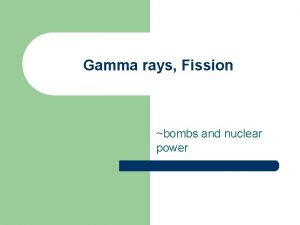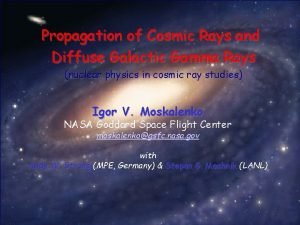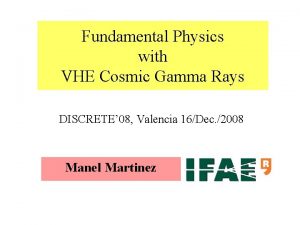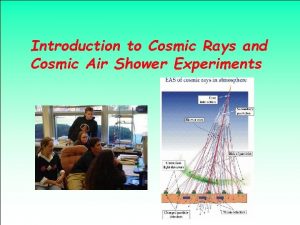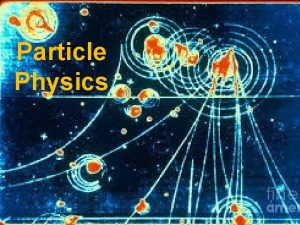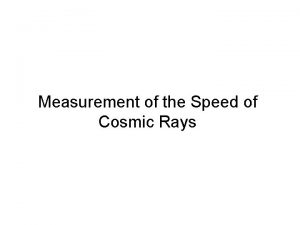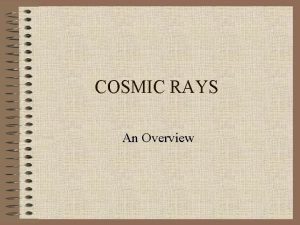Cosmic Rays Gamma Rays and Multi Messenger Astronomy






























































- Slides: 62

Cosmic Rays, Gamma Rays and Multi Messenger Astronomy Part 2 Jacques Paul CEA IRFU, Service d’Astrophysique, Saclay 7 July International School of Astronomy and Astrophysics 2012 Multi-Messenger Approach in High Energy Astrophysics APC Paris

Space gamma-ray astronomy For a complete review on space activities, please refer to the lecture on “Astroparticles in space" to be given next week by Olivier La Marle. J. Paul ISAPP 2012 – Cosmic Rays, Gamma Rays and Multi Messenger Astronomy – APC Paris – 7 July 2012 Slide 2

Guiseppe (Beppo) Occhialini (1907 -1993) Prominent particle physicist Founding Father of the European space research One of the first to understand the importance of gamma-ray astronomy J. Paul ISAPP 2012 – Cosmic Rays, Gamma Rays and Multi Messenger Astronomy – APC Paris – 7 July 2012 Slide 3

The beginnings of gamma-ray astronomy Up to the end of the 1960 s, gamma-ray astronomy was solely based on theoretical considerations, whose overly optimistic predictions proved to be rather accurate as concerned the nature of the gamma-ray sources. During the 1950 s, such predictions took advantage of the discoveries reported by radio astronomers, as e. g. the detection of huge amounts of atomic hydrogen in the Galaxy thanks to the first 21 cm observations. Mc. Gee, Murray (1961), Australian Journal of Phys, vol. 14, pp. 260 -278. J. Paul ISAPP 2012 – Cosmic Rays, Gamma Rays and Multi Messenger Astronomy – APC Paris – 7 July 2012 Slide 4

A long expectation 1952 Prediction of the high-energy gamma-ray emission of the Galactic disk via p-p interactions Hayakawa (1952), Prog. Theor. Phys. , vol. 8, p. 571. 1958 Inventory of the cosmic sites expected to radiate gamma rays: It include the Crab Nebula, Cyg A and the Sun Morrison (1958), Nuovo Cimento, vol. 7, p. 858. 1958 First detection of cosmic gamma rays during a solar flare Peterson, Winckler (1958), Phys. Rev. Let. , vol. 1, p. 205. 1967 First exhaustive revue devoted to gamma-ray astronomy “Ten years after the launch of Sputnik 1, one had not succeeded in definitely detecting any gamma rays from cosmic sites localized beyond the solar system” Fazio (1967), ARA&A, vol. 5, p. 481. J. Paul ISAPP 2012 – Cosmic Rays, Gamma Rays and Multi Messenger Astronomy – APC Paris – 7 July 2012 Slide 5

First detection of cosmic gamma rays Rate (× 10 -4 s-1) 1968 Discovery of the high-energy (> 100 Me. V) galactic gamma-ray emission with a pair-production detector aboard OSO III Clark et al. (1968), Ap. J, vol. 153, p. L 203. 3 2 1 -90 -60 -30 0 30 60 90 Galactic latitude (deg. ) OSO III (1967 -1969) J. Paul Galactic emission latitude profile ISAPP 2012 – Cosmic Rays, Gamma Rays and Multi Messenger Astronomy – APC Paris – 7 July 2012 Slide 6

First detection of gamma-ray bursts Detector count rate (counts s-1) 1973 Report on the detection of gamma-ray bursts by the Vela satellites Klebesadel et al. (1973), Ap. J vol. 182, p. L 85. Artist view of a Vela satellite J. Paul 103 Vela 5 A 102 101 103 Vela 6 B 102 101 -40 0 0. 1 Time (mn) 1 10 Time (s) Lin. scale Log. scale 100 Light curve of GRB 700822 ISAPP 2012 – Cosmic Rays, Gamma Rays and Multi Messenger Astronomy – APC Paris – 7 July 2012 Slide 7

High-energy observatories of the 1970’s 1972 Launch of SAS-2, interruption of the data taking after 8 months due to the failure of a low-voltage power supply 1975 Launch of COS-B, the first European Space Agency satellite Nov. 1972 -June 1973 J. Paul Aug. 1975 -April 1982 ISAPP 2012 – Cosmic Rays, Gamma Rays and Multi Messenger Astronomy – APC Paris – 7 July 2012 Slide 8

(degrees) Galactic latitude COS-B major outcomes +20 150 120 90 60 30 0 330 300 270 240 210 180 Galactic longitude (degrees) Mayer-Hasselwander et al. (1982), A&A, vol. 107, p. 390. Swanenburg et al. (1981), Ap. J, vol. 243, p. 69. J. Paul ISAPP 2012 – Cosmic Rays, Gamma Rays and Multi Messenger Astronomy – APC Paris – 7 July 2012 Slide 9

Gamma-ray observatories of the 1990’s 1990 Following a period of little activity (Challenger disaster), the 1990 s were a golden decade for space gamma-ray astronomy owing to a new generation of gamma telescopes aboard GRANAT and CGRO. GRANAT In operation from 1990 until 1997 J. Paul CGRO In operation from 1991 until 2000 ISAPP 2012 – Cosmic Rays, Gamma Rays and Multi Messenger Astronomy – APC Paris – 7 July 2012 Slide 10

SIGMA/GRANAT major outcomes Galactic latitude (degrees) Low-energy gamma-ray studies of the Galactic Center region Goldwurm et al. (1994), Nat, vol. 371, p. 589. Contribution to the discovery of microquasars Mirabel et al. (1992), Nat, vol. 358, p. 215. 6 4 2 1 E 1740. 7 -2942 0 4 2 0 358 356 354 Galactic longitude (degrees) J. Paul ISAPP 2012 – Cosmic Rays, Gamma Rays and Multi Messenger Astronomy – APC Paris – 7 July 2012 Slide 11

EGRET/CGRO major outcomes EGRET High-energy gamma-ray survey revealing tens of blazars Hartman et al. (1999), Ap. JS, vol. 123, p. 79. J. Paul ISAPP 2012 – Cosmic Rays, Gamma Rays and Multi Messenger Astronomy – APC Paris – 7 July 2012 Slide 12

Galactic gamma-ray emission c kp 4 100 -300 Me. V longitude profile of the Gamma-ray emission measured by EGRET in the – 2° < b < 2° latitude interval (point sources subtracted) Hunter et al. (1997), Ap. J, vol. 481, p. 205. J. Paul The gamma-ray emission from the Galactic disk originate mainly from the 4 kpc molecular ring as revealed by mm observations ISAPP 2012 – Cosmic Rays, Gamma Rays and Multi Messenger Astronomy – APC Paris – 7 July 2012 Slide 13

BATS/CGRO major outcomes 1000 N (> Φ) 100 10 1 1 10 Fluence Φ (cm-2 s-1) 100 The 2704 GRBs detected by BATSE are Deficit of weak bursts in case of a population uniformly distributed on the celestial sphere uniformly distributed in an Euclidean space J. Paul ISAPP 2012 – Cosmic Rays, Gamma Rays and Multi Messenger Astronomy – APC Paris – 7 July 2012 Slide 14

The gamma-ray domain Upper bound no limit… …except those implied by detection processes At ~ 10 Pe. V, one expects only few photons km-2 day-1 Lower bound endless – but instructive – debate on the boundary between X rays and gamma rays Question: at which energy begins the gamma-ray domain? J. Paul ISAPP 2012 – Cosmic Rays, Gamma Rays and Multi Messenger Astronomy – APC Paris – 7 July 2012 Slide 15

Possible answers From the literature 100 ke. V Fazio (1967), ARA&A, vol. 5, p. 480. 50 ke. V Macomb, Gehrels (1999), Ap. JS, vol. 120, p. 335. From the nature of the emission processes Continuum emissions: no clear indication Line emissions: conflicting indications A plausible answer: 20 ke. V… Although arbitrary, this limit refers to significant facts Astrophysical facts Experimental facts J. Paul ISAPP 2012 – Cosmic Rays, Gamma Rays and Multi Messenger Astronomy – APC Paris – 7 July 2012 Slide 16

Astrophysical facts Most stars radiate thermal emission ± similar to that of a blackbody Two conditions to sustain blackbody emission: 1 The luminosity cannot exceed the Eddington limit 4 π R 2 σ T 4 1. 3 × 10 38 (M / M ) erg s -1 2 The radius must exceed the Schwarzschild radius R > 2 M G / c 2 The radius upper limit is then: R < 475 (T / 10 7) - 4 km Beyond 20 ke. V, thermal processes give way to non-thermal J. Paul ISAPP 2012 – Cosmic Rays, Gamma Rays and Multi Messenger Astronomy – APC Paris – 7 July 2012 Slide 17

Experimental facts photons of energy > 20 ke. V Photons of energy < 20 ke. V J. Paul ISAPP 2012 – Cosmic Rays, Gamma Rays and Multi Messenger Astronomy – APC Paris – 7 July 2012 Slide 18

Why gamma-ray astronomy? The specific character of the emission processes Interactions of HE particles with matter, magnetic & photons fields Decay of unstable particles induced by p-p interactions Matter-antimatter annihilation Nuclear de-excitation The diversity of the emission sites High-temperature plasmas confined by compact objects (NS, BH) Relativistic plasmas Diluted media crossed by accelerated particles Media “contaminated” by radioactive species The extreme luminosity of gamma-ray sources High-z Universe The penetrating power of HE radiation J. Paul ISAPP 2012 – Cosmic Rays, Gamma Rays and Multi Messenger Astronomy – APC Paris – 7 July 2012 Slide 19

Compact (point like) gamma-ray sources Sites where extreme physical conditions prevail: intense gravity fields, very high temperatures, strong magnetic and electric fields Transient source Host galaxy SN 1994 d GRB 011121 Messier 87 1 E 1740. 7 -2942 An apparently ill-assorted gallery of cosmic sites, but. . . All sites give way to the fatal attraction of gravity Many sites produce copious outflows of relativistic matter Privileged messengers: gamma-ray photons, neutrinos, cosmic rays, gravitational waves J. Paul ISAPP 2012 – Cosmic Rays, Gamma Rays and Multi Messenger Astronomy – APC Paris – 7 July 2012 Slide 20

All sky surveys Gamma rays (Eγ > 100 Me. V) Gamma rays (Eγ = 1. 8 Me. V) Gamma rays (Eγ = 511 ke. V) J. Paul ISAPP 2012 – Cosmic Rays, Gamma Rays and Multi Messenger Astronomy – APC Paris – 7 July 2012 Slide 21

The atmospheric screen Altitude (km) 100 Atmospheric transmission reduced by 50% 80 60 40 20 radio J. Paul IR V UV X gamma ISAPP 2012 – Cosmic Rays, Gamma Rays and Multi Messenger Astronomy – APC Paris – 7 July 2012 Slide 22

J. Paul 10 0 k e. V From space From ground HESS 10 0 M e. V 10 0 G e. V 10 Te V 1 T e. V 10 0 T e. V 1 P e. V Exploring the gamma-ray domain Fermi INTEGRAL ISAPP 2012 – Cosmic Rays, Gamma Rays and Multi Messenger Astronomy – APC Paris – 7 July 2012 Slide 23

Specificities of space gamma-ray astronomy Space gamma-ray astronomers face a threefold handicap: Gamma rays cannot be reflected and need dense detection material Detection area = collecting area Large and massive detectors At equal luminosity, gamma-ray sources radiate much less photons Very long observing time (days, weeks) Necessity of wide fields of view Space devices are exposed to huge fluxes of charged particles that… …produce detection effects similar to those of cosmic gamma rays …produce secondary gamma in the detector and surrounding material The resulting background makes gamma observations as prohibitive as observations in the visible performed in broad daylight! J. Paul ISAPP 2012 – Cosmic Rays, Gamma Rays and Multi Messenger Astronomy – APC Paris – 7 July 2012 Slide 24

Detection processes Photoelectric effect Absorption of a photon of energy E 0 with ejection of a bound electron: E = E 0 – EBINDING Compton scattering The energy E 1 (E 1 < E 0) of the scattered photon is related to its energy E 0 and to the scattering angle θ according to: E 0 E 1 = –––––––– E 0 (1 – cos θ) 1– –––––– me c 2 Pair creation A photon of energy E 0 > 2 mec 2 creates in the intense electric field of a nucleus an electron-positron pair such as: E 0 = E 1+ E 2+ 2 mec 2 J. Paul ISAPP 2012 – Cosmic Rays, Gamma Rays and Multi Messenger Astronomy – APC Paris – 7 July 2012 Slide 25

Mass attenuation coefficient (cm 2 g-1) Diffusive material: aluminum 103 102 Photoelectric 10 1 10 -1 Compton 10 -2 Pair 1 J. Paul 10 102 103 Energy (ke. V) 104 ISAPP 2012 – Cosmic Rays, Gamma Rays and Multi Messenger Astronomy – APC Paris – 7 July 2012 Slide 26

Mass attenuation coefficient (cm 2 g-1) Absorbing material: lead 104 103 Photoelectric 102 10 1 10 -1 Compton 10 -2 1 J. Paul 10 102 103 Energy (ke. V) Pair 104 ISAPP 2012 – Cosmic Rays, Gamma Rays and Multi Messenger Astronomy – APC Paris – 7 July 2012 Slide 27

Imaging technique in gamma-ray astronomy Cosmic-ray sources (sites where cosmic rays are accelerated to relativistic energies) are likely to be also sources of copious gamma-ray radiation… BUT The gamma-ray radiation cannot be reflected since its wavelength is much below the inter-atomic distances in solids. Then to localize sources, gamma-ray telescopes cannot features classical arrangements of mirrors and specific imaging techniques have to be worked out. Straightforward imaging techniques are based on the modulation of the incident radiation, such as collimators and coded apertures. More sophisticated techniques take advantage of the properties of the interaction processes (Compton diffusion/pair production) to estimate the arrival direction of incident photons. J. Paul ISAPP 2012 – Cosmic Rays, Gamma Rays and Multi Messenger Astronomy – APC Paris – 7 July 2012 Slide 28

Collimators The simplest optical device to determine gamma-ray incident direction collimator detector Main issues are: Induced background Opacity vs mass On-Off technique J. Paul ISAPP 2012 – Cosmic Rays, Gamma Rays and Multi Messenger Astronomy – APC Paris – 7 July 2012 Slide 29

Coded aperture J. Paul ISAPP 2012 – Cosmic Rays, Gamma Rays and Multi Messenger Astronomy – APC Paris – 7 July 2012 Slide 30

Coded aperture imaging matrix algebra Sγ (sky) The distribution of the source intensities in the field of view M (mask) The distribution of opaque and transparent mask elements D (detector) If is the cyclic convolution operator D = M Sγ W (sky image) Can be constructed in a unique way if M is invertible This condition holds if it exists G such as: G M = δ In such a case, the sky image is: W = G D Implying: W = G M Sγ W = Sγ since G M = δ The Uniformly Redundant Array (URA), meets the above conditions while minimizing the background contribution Fenimore, Cannon (1978), Applied Optics, vol. 17, p. 337. J. Paul ISAPP 2012 – Cosmic Rays, Gamma Rays and Multi Messenger Astronomy – APC Paris – 7 July 2012 Slide 31

SIGMA: the precursor First space coded mask gamma-ray telescope to operate in space Energy band: 35 ke. V to 1. 3 Me. V; angular resolution: 13 arc minutes Paul et al. (1991), Adv. in Sp. Res. , vol. 11, p. (8)289. J. Paul ISAPP 2012 – Cosmic Rays, Gamma Rays and Multi Messenger Astronomy – APC Paris – 7 July 2012 Slide 32

It works! observation decoding transmission J. Paul ISAPP 2012 – Cosmic Rays, Gamma Rays and Multi Messenger Astronomy – APC Paris – 7 July 2012 Slide 33

Compton telescope A basic Compton telescope features two layer of position sensitive detectors Layer 1: made of diffusive material to scatter the incident gamma ray Layer 2: made of absorbing material to absorb the scattered photon Φ Telescope axis Ψ θ Both incoming photon incidence angle Φ and energy E 0 can be derived from the energy deposits E 1 in layer 1 and E 2 in layer 2 and from the angle Ψ of the scattered photon J. Paul ISAPP 2012 – Cosmic Rays, Gamma Rays and Multi Messenger Astronomy – APC Paris – 7 July 2012 Slide 34

Gamma-ray polarimetry incident photon c i r t c ele or vect scattered photon α Photon fairly scattered in a plane perpendicular to its electric vector Azimuthal distribution of scattered photons (α angle) around the source direction allows an estimate of the degree of linear polarization Method successfully tested in the case of INTEGRAL Forot et al. (2008), Ap. J, vol. 688, p. L 29. J. Paul ISAPP 2012 – Cosmic Rays, Gamma Rays and Multi Messenger Astronomy – APC Paris – 7 July 2012 Slide 35

Pair production telescope Incident photon whose energy Eγ > 2 mec 2 (Eγ > 1. 022 Me. V) can induce an e--e+ pair in the intense electric field close to an atomic nucleus Particle trajectories do not markedly deviate from the photon direction as soon as the photon energy Eγ >> 2 mec 2 charged particle anticoincidence shield pair conversion foils particle tracking detectors calorimeter e+ e- The mean electron pair deviation θ is given by: In case of Eγ = 100 Me. V, the mean deviation θ ~ 1. 5° J. Paul ISAPP 2012 – Cosmic Rays, Gamma Rays and Multi Messenger Astronomy – APC Paris – 7 July 2012 Slide 36

Towards a grazing incidence telescope Grazing incidence telescope using Wolter I optics are governed by: (ke. V) = k F / D E M (ke. V) = k F One simple way to operate beyond 20 ke. V is to markedly increase the focal length Absolute necessity of bringing into operation two satellites in close formation J. Paul . 5 m = 7 nce ista al d Foc EM is the spectral upper bound D is the mirror diameter F is the telescope focal length k is a coefficient depending of the reflecting surface (for gold, k = 1) Focal plane ISAPP 2012 – Cosmic Rays, Gamma Rays and Multi Messenger Astronomy – APC Paris – 7 July 2012 Slide 37

Multi-wavelength astronomy J. Paul ISAPP 2012 – Cosmic Rays, Gamma Rays and Multi Messenger Astronomy – APC Paris – 7 July 2012 Slide 38

Usefulness of multi-wavelength observations 1031 visible 1030 νFν (W) 1029 radio X rays soft hard gamma rays from space from ground 1028 1027 10 Ge. V 300 Ge. V Crab Nebula 1026 1010 10 Te. V 1015 1020 Frequency ν (Hz) 1025 1030 Thanks to the non-thermal nature of the emission processes gamma-ray sources can be profitably observed at longer wavelengths J. Paul ISAPP 2012 – Cosmic Rays, Gamma Rays and Multi Messenger Astronomy – APC Paris – 7 July 2012 Slide 39

Multi-wavelength view of the galactic disk J. Paul ISAPP 2012 – Cosmic Rays, Gamma Rays and Multi Messenger Astronomy – APC Paris – 7 July 2012 Slide 40

Multi-wavelength observations and cosmic rays Studies combining data on the distribution of the gas (atomic and molecular)… …as well as radio waves and gamma-ray observations of the Galactic disk provided reliable information on the distribution of cosmic rays throughout the Galactic disk and on the sources of cosmic rays within the Galaxy Paul, Cassé, Cesarsky (1976), Ap. J, vol. 207, pp. 62 -77. Paul, Cassé, Cesarsky (1976), J. Paul ISAPP 2012 – Cosmic Rays, Gamma Rays and Multi Messenger Astronomy – APC Paris – 7 July 2012 Slide 41

Multi-wavelength discovery of microquasars Galactic latitude (degrees) In 1990, the first accurate images of GC region obtained with the SIGMA coded-mask telescope aboard GRANAT prompted a multi-wavelength campaign to investigate the newly discovered hard source 1 E 1740 -2942. 6 4 2 1 E 1740. 7 -2942 0 4 2 0 358 356 354 Galactic longitude (degrees) J. Paul ISAPP 2012 – Cosmic Rays, Gamma Rays and Multi Messenger Astronomy – APC Paris – 7 July 2012 Slide 42

Multi-wavelength discovery of microquasars The multi-wavelength campaign included the VLA, a radio interferometer designed to perform observations with a very high angular resolution J. Paul ISAPP 2012 – Cosmic Rays, Gamma Rays and Multi Messenger Astronomy – APC Paris – 7 July 2012 Slide 43

Multi-wavelength discovery of microquasars Mirabel et al. (1992), Nat, vol. 358, p. 215. J. Paul ISAPP 2012 – Cosmic Rays, Gamma Rays and Multi Messenger Astronomy – APC Paris – 7 July 2012 Slide 44

Multi-wavelength study of microquasars In 1992, the SIGMA observation of a long outburst of GRS 1915+105 prompted a similar multi-wavelength campaign to monitor the source. In 1994, the VLA enabled the detection of superluminal motion similar to that observed in AGN, a new justification of the name microquasar. Mirabel, Rodriguez (1994) Nat, vol. 371, pp. 46 -48 J. Paul ISAPP 2012 – Cosmic Rays, Gamma Rays and Multi Messenger Astronomy – APC Paris – 7 July 2012 Slide 45

Multi-wavelength study of microquasars Luminosity (arbitrary unit) 0 1. 0 Separation (106 km) 200 400 600 800 X rays infrared radio 0. 5 0. 0 disk emptying 7. 9 8. 0 ejection 8. 1 8. 2 8. 3 8. 4 8. 5 Time (hours) 8. 6 8. 7 8. 8 8. 9 Detailed evolution of the matter ejection from GRS 1915+105 J. Paul ISAPP 2012 – Cosmic Rays, Gamma Rays and Multi Messenger Astronomy – APC Paris – 7 July 2012 Slide 46

Polarized gamma rays from Cygnus X-1 power-law fit to the 400 -2000 ke. V data points (photon index 1. 6) Two spectral components Exposure: 5× 106 s (58 days) 10 -2 Photon cm-2 s-1 ke. V-1 Comptonization spectrum adjusted to the 20 -150 ke. V data points 10 -3 10 -4 10 -5 10 -6 100 Energy (ke. V) 1000 Polarization fraction < 20% (250 -400 ke. V) 67± 30% (400 -2000 ke. V) Laurent et al. (2011), Science, vol. 332, p. 438. (2011), J. Paul ISAPP 2012 – Cosmic Rays, Gamma Rays and Multi Messenger Astronomy – APC Paris – 7 July 2012 Slide 47

A jet origin for gamma rays at E>400 ke. V High degree of polarization implies that the magnetic field is coherent over the emission site jet origin strongly favored The photon spectrum >400 ke. V is a power law of index α=1. 6 Electron spectrum is also a power law of index p=2. 2 consistent with the canonical value p=2 for shock-accelerated particles For B ~10 m. G, electron energy would be around a few Te. V J. Paul ISAPP 2012 – Cosmic Rays, Gamma Rays and Multi Messenger Astronomy – APC Paris – 7 July 2012 Slide 48

The case of gamma-ray burst J. Paul ISAPP 2012 – Cosmic Rays, Gamma Rays and Multi Messenger Astronomy – APC Paris – 7 July 2012 Slide 49

An unexpected consequence of the Cold War J. Paul ISAPP 2012 – Cosmic Rays, Gamma Rays and Multi Messenger Astronomy – APC Paris – 7 July 2012 Slide 50

2 July 1967: First GRB ever detected Count rate (counts s-1) 1500 1000 500 0 -2 0 2 Time (s) 4 6 8 After Klebesadel et al. (1973), Ap. J, vol. 182, p. L 85. J. Paul ISAPP 2012 – Cosmic Rays, Gamma Rays and Multi Messenger Astronomy – APC Paris – 7 July 2012 Slide 51

Time-of-arrival location technique S 1 θ 12 S 2 T 1 T 2 S 1 θ 12 S 2 Cos θ 12 = c (T 2 -T 1) / S 1 S 2 J. Paul ISAPP 2012 – Cosmic Rays, Gamma Rays and Multi Messenger Astronomy – APC Paris – 7 July 2012 Slide 52

The interplanetary network in 1979 J. Paul ISAPP 2012 – Cosmic Rays, Gamma Rays and Multi Messenger Astronomy – APC Paris – 7 July 2012 Slide 53

The 5 March 1979 event Chandra X-ray image of N 49 Firm identification with the SNR N 49 in the LMC J. Paul ISAPP 2012 – Cosmic Rays, Gamma Rays and Multi Messenger Astronomy – APC Paris – 7 July 2012 Slide 54

Magnetar SGR ≠ GRB J. Paul ISAPP 2012 – Cosmic Rays, Gamma Rays and Multi Messenger Astronomy – APC Paris – 7 July 2012 Slide 55

SGR 1806 -20 giant flare December 27, 2004 counts s-1 106 Initial peak 2 106 0 0, 5 Afterglow emission 1 9 104 105 Precursor 60 -120 -60 0 60 120 180 120 240 180 300 Time (s) after 21: 30: 26: 539 UT Mereghetti et al. (2005), Ap. J, vol. 624, p. L 105. J. Paul ISAPP 2012 – Cosmic Rays, Gamma Rays and Multi Messenger Astronomy – APC Paris – 7 July 2012 Slide 56

CGRO/BATSE: unprecedented statistics The 2704 GRBs detected by BATSE are uniformly distributed on the celestial sphere J. Paul ISAPP 2012 – Cosmic Rays, Gamma Rays and Multi Messenger Astronomy – APC Paris – 7 July 2012 Slide 57

1996: Beppo. SAX Launched in 1996 and operated for 6 years, it was the first X-ray mission covering more than 3 decades of energy, from 0. 1 to 300 ke. V J. Paul ISAPP 2012 – Cosmic Rays, Gamma Rays and Multi Messenger Astronomy – APC Paris – 7 July 2012 Slide 58

Most GRBs are cosmological Afterglow of GRB 971214 detected by Beppo. SAX in the X-ray band T + 6, 5 h Afterglow in the visible band T + 12 h T + 52 h Detection of host galaxies Redshift measurements Cosmological distances Most energetic events 1044 J radiated in gamma rays J. Paul ISAPP 2012 – Cosmic Rays, Gamma Rays and Multi Messenger Astronomy – APC Paris – 7 July 2012 Slide 59

The fireball shock scenario Meszaros (2002), ARA&A, vol. 40, p. 137. For a complete review on GRB physics, please refer to the lecture on “Explosive phenomena" to be given next week by Frédéric Daigne. J. Paul ISAPP 2012 – Cosmic Rays, Gamma Rays and Multi Messenger Astronomy – APC Paris – 7 July 2012 Slide 60

Universality of relativistic jets MICROQUASAR X-ray visible radio accretion disk R~100 km BH 3 -10 M GRB few light hours star relativistic jet X-rays star gamma-rays accretion disk R~105 km BH 3 -10 M MICROBLAZAR few light years X-ray radio relativistic jet J. Paul QUASAR relativistic jet host X, UV galaxy visible accretion disk R~109 km BH 108 -9 M millions of light years COLLAPSAR BLAZAR ISAPP 2012 – Cosmic Rays, Gamma Rays and Multi Messenger Astronomy – APC Paris – 7 July 2012 Slide 61

“Maids of all works” of particle astrophysics In the framework of the “standard” model of GRBs, many theoreticians anticipate that GRBs could be sources of: Ultra high energy cosmic rays High energy neutrinos Gravitational waves J. Paul ISAPP 2012 – Cosmic Rays, Gamma Rays and Multi Messenger Astronomy – APC Paris – 7 July 2012 Slide 62
 Svensmark
Svensmark Our cosmic address is
Our cosmic address is Learning astronomy by doing astronomy activity 1 answers
Learning astronomy by doing astronomy activity 1 answers Learning astronomy by doing astronomy activity 1 answers
Learning astronomy by doing astronomy activity 1 answers Learning astronomy by doing astronomy
Learning astronomy by doing astronomy Cosmic rays discoverer
Cosmic rays discoverer Coracu
Coracu Cosmic rays
Cosmic rays Cosmic rays
Cosmic rays Cosmic rays
Cosmic rays Origin of gamma rays
Origin of gamma rays Who discovered gamma rays
Who discovered gamma rays Gamma rays uses
Gamma rays uses Cobalt-60 uses in food
Cobalt-60 uses in food Images of gamma rays
Images of gamma rays Characteristics of ultraviolet rays
Characteristics of ultraviolet rays Waiting line management
Waiting line management Multi loop pid controller regolatore pid multi loop
Multi loop pid controller regolatore pid multi loop Astronomy questions and answers multiple choice
Astronomy questions and answers multiple choice Michigan state university physics
Michigan state university physics Ed kennedy characterization
Ed kennedy characterization Greek messenger
Greek messenger Instant messenger msn
Instant messenger msn Squiggle messenger download
Squiggle messenger download Messenger rna sequence
Messenger rna sequence![Whose “great days [are] like ghosts gone”? Whose “great days [are] like ghosts gone”?](data:image/svg+xml,%3Csvg%20xmlns=%22http://www.w3.org/2000/svg%22%20viewBox=%220%200%20200%20200%22%3E%3C/svg%3E) Whose “great days [are] like ghosts gone”?
Whose “great days [are] like ghosts gone”? Last messenger of god
Last messenger of god Kairos messenger
Kairos messenger Indeed in the messenger of allah
Indeed in the messenger of allah Bev kennedy i am the messenger
Bev kennedy i am the messenger Messenger rna sequence
Messenger rna sequence Messenger rna sequence
Messenger rna sequence A-t c-g dna
A-t c-g dna Real life calculator
Real life calculator Msn messenger chat rooms
Msn messenger chat rooms Messenger
Messenger Dynamic messenger
Dynamic messenger What does jocasta say she did with her baby
What does jocasta say she did with her baby Jonah 1:2-12
Jonah 1:2-12 Messenger of god planet
Messenger of god planet Secondary messenger
Secondary messenger Secondary messenger
Secondary messenger Messenger
Messenger Rsview
Rsview Second messenger hypothesis
Second messenger hypothesis Messenger
Messenger Messenger
Messenger Calculator messenger
Calculator messenger Yahoo messenger
Yahoo messenger Messenger
Messenger The messenger trainer
The messenger trainer Bebo messenger
Bebo messenger Secure communication platform
Secure communication platform 2 corinthians 12 7 10
2 corinthians 12 7 10 Messenger brak ankiety
Messenger brak ankiety I miss you allah
I miss you allah Messenger web
Messenger web Protein synthesis
Protein synthesis Pidgin facebook messenger
Pidgin facebook messenger Which lipid acts as a chemical messenger
Which lipid acts as a chemical messenger Somatic motor pathways
Somatic motor pathways What is the stretch reflex
What is the stretch reflex Ecological diversity is a measure of the number of
Ecological diversity is a measure of the number of
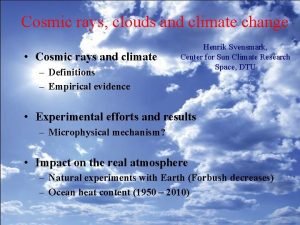
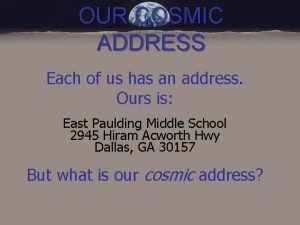



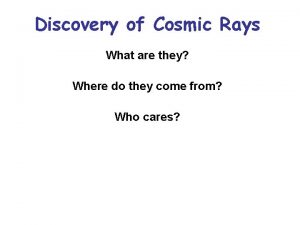
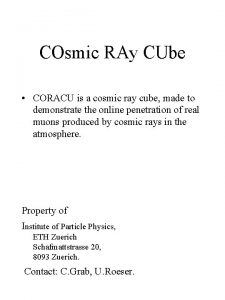
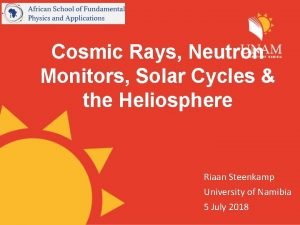
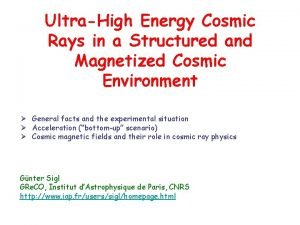
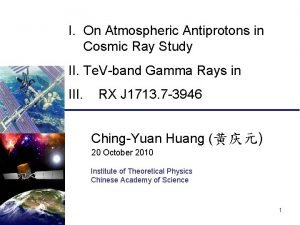
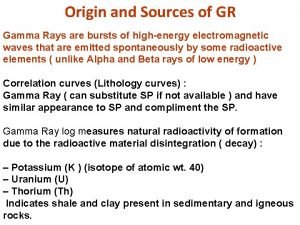
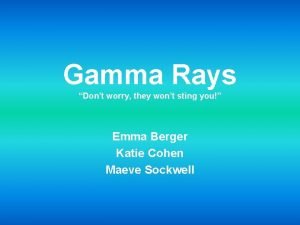
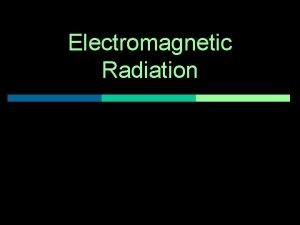


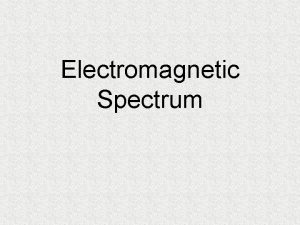









![Whose “great days [are] like ghosts gone”? Whose “great days [are] like ghosts gone”?](https://slidetodoc.com/wp-content/uploads/2020/11/2050204_75c6504015ea85c6b90e3c752477dfe7-300x225.jpg)






